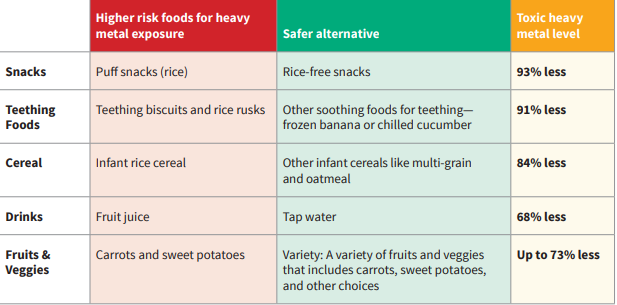Toxic Heavy Metals in Baby Food
Last week, a subcommittee of the U.S. House Committee on Oversight and Reform announced it found that ingredients in many baby foods are contaminated with heavy metals like arsenic, lead and cadmium. Through testing loopholes and lax regulation, multi-billion dollar companies are not being held accountable by our government and withhold information about whether their products potentially threaten the health of our children. Find our breakdown below and learn how you can keep your family safe.
What is the concern?
Our colleagues at Healthy Babies Bright Futures (HBBF) highlight that 88% of the food they tested in 2019 have no enforceable federal safety limit for arsenic, lead and other heavy metals.
In 2018, Consumer Reports tested 50 nationally distributed baby food products for cadmium, lead, mercury and arsenic. Every product they tested contained measurable levels of at least one of these harmful heavy metals. Two-thirds of the products had levels of heavy metals that raised concern about potential harmful levels of exposure. Fifteen of the products would pose potential health risks to a child eating less than one serving a day.
What can parents do?
HBBF recommends that parents replace rice-based puffs, teething biscuits and cereal with rice-free alternatives, limit certain fruit juices, and select a variety of vegetable-based foods, limiting the amount of carrots and sweet potatoes.

HBBF’s full test results and the full report can be found here.
What else can be done to reduce exposures?
The baby food market was valued at $12.9 billion in 2018 and is expected to reach over $17 billion by 2026. Both Consumer Reports and HBBF note that this is a largely unregulated market; HBBF calls for increasing review and regulation of baby food ingredients, particularly arsenic:
- FDA should establish and finalize health-protective standards for heavy metals, prioritizing foods that offer the greatest opportunity to reduce exposure, considering additive effects of the multiple metals detected in foods, and explicitly protecting against neurodevelopmental impacts.
- FDA should implement a proactive testing program for heavy metals in foods consumed by babies and toddlers, similar to the Consumer Product Safety Commission’s program for children’s toys (CPSC 2019).
- Because inorganic arsenic in rice is a top source of neurodevelopmental risk for children, FDA should act immediately to establish a health-based limit for this chemical in infant rice cereal and other rice-based foods. In setting its 2016 proposed action level, the agency did not consider IQ loss or other forms of neurological impact, allowed cancer risks far outside of protective limits, and failed to account for children who have unusually high exposures to arsenic in rice (HBBF 2016). Rapid action by FDA to set a protective level will protect children from high levels of arsenic in rice.
Where does the arsenic in baby food come from?
While some arsenic is naturally occurring, most arsenic that accumulates in rice and apples and other foods comes from soil and water contaminated from arsenic-based pesticides used decades ago, which is why even organic products may still contain this compound.
How can we minimize exposure to this toxic legacy pesticide?
Encouragingly, sixteen of the products tested by Consumer Reports had markedly lower concentrations of heavy metals, suggesting that manufacturers can potentially reduce the levels of heavy metals in their products. HBBF’s 2019 recommendations include suggestions for removing arsenic contamination from rice-based products:
- To reduce arsenic levels, solutions suggested by FDA and other experts include sourcing rice from fields with lower arsenic levels in soil, growing it with natural soil additives that reduce arsenic uptake by the roots, growing rice strains less prone to arsenic uptake, altering irrigation practices, preparing rice with excess water that is poured off, and blending it with lower arsenic grains in multi-grain products.
How has CEH been dedicated to protecting infant and child health?
Since our founding 25 years ago, CEH has set out to hold companies accountable for the toxic foods and products they market for kids. This has included testing, advocacy and legal action to get chemicals out of our children’s nap and play mats, lunchboxes, bibs, toys, jewelry, playgrounds, and getting toxic metals like lead, cadmium and arsenic out of children’s candy, cereals, and other foods.
CEH commits to testing products like these to share the truth with consumers, and supporting our colleagues in keeping pressure on lawmakers to set health- protective standards for heavy metals and other toxic chemicals in food and consumer products and for companies to take urgent action to eliminate heavy metals from baby and toddler food.
